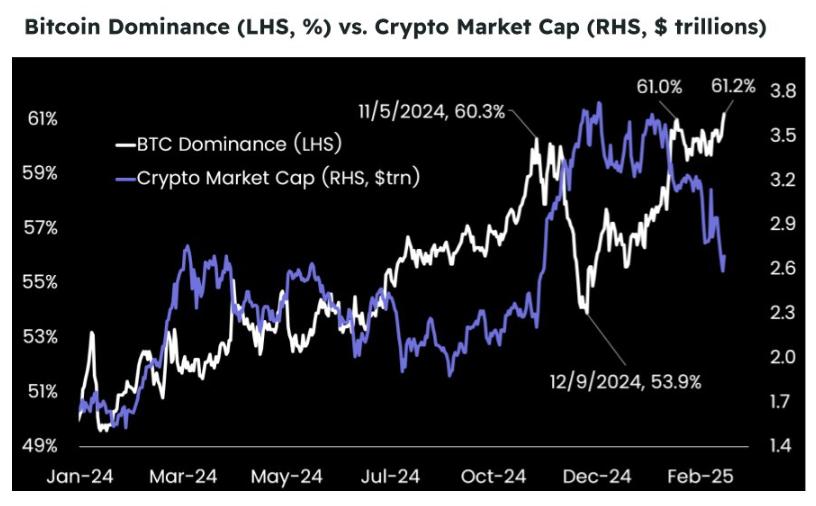Author: Bitfinex Alpha
Translated by: Tim, PANews
Bitcoin recorded its worst performance in nearly a decade during the first quarter of 2025, despite initially surging to a historical high of $109,590 at the beginning of the year, closing the quarter with nearly an 11% decline. The initial market optimism about Trump's potential election and pro-crypto policies quickly transformed into a textbook "sell the fact" scenario as substantial regulatory reforms failed to materialize. Since its historical peak, Bitcoin dropped to as low as $77,041, with a maximum drawdown of nearly 29%, subsequently oscillating primarily within the $78,000 to $88,000 trading range.

However, the market structure remains favorable for Bitcoin. Despite a significant drop in total cryptocurrency market capitalization, Bitcoin's dominance has risen to over 61%, indicating that funds are rotating from higher-risk Altcoins to Bitcoin in an environment of increasing macroeconomic uncertainty. Altcoins like Ethereum and Solana have fallen 35%-50% from their cycle highs, further strengthening Bitcoin's position as the "reserve asset" of the crypto market.
As the second quarter begins, market price trends remain highly dependent on macroeconomic signals, with the Federal Reserve's policy direction and ETF fund flows continuing to dominate market direction. Although signs of panic selling by investors have somewhat subsided, the market still needs a sufficiently influential catalyst event to form a trend-breaking breakthrough in an environment of continued liquidity tightening.
From a macroeconomic perspective, certain areas of the US economy are showing resilience, such as narrowing trade deficits and increased durable goods spending, but these highlights are overshadowed by deeper structural concerns. Factors like new tariff policies driving up import costs have accelerated inflation beyond expectations. The core inflation rate increased by 0.4% month-on-month in February, marking the largest monthly increase in over a year, while consumer expectations suggest inflation may remain high for an extended period.

Personal Disposable Income, Expenditure, and Savings
Meanwhile, economic growth is slowing. Real income growth remains weak when excluding government spending, and service sector expenditure, a key economic driver, has begun to shrink. Consumer confidence continues to decline, with the Conference Board Consumer Confidence Index falling to a two-year low, and more Americans expecting unemployment to rise. These trends indicate increasing caution among households, specifically manifested in continuously rising personal savings rates.
Trade policy remains a core pressure point. Recent tariff increases and market expectations of potential further measures in April and May are prompting businesses and consumers to adjust their behavior, including advance purchasing, delaying investments, or reducing hiring. Although the trade deficit narrowed in February, this follows an import surge in January, which may have already been factored into GDP predictions. Consequently, economic growth in the first quarter is expected to significantly slow down.
Despite ongoing economic uncertainty, the crypto industry continues to benefit from a friendly political environment, with the Trump administration promoting increasingly clear regulatory frameworks, and institutional participation continuously growing.
The US Securities and Exchange Commission has officially withdrawn lawsuits against three major industry participants: Kraken, ConsenSys, and Cumberland DRW. This move signals a shift from a previously strict enforcement stance to a more collaborative regulatory approach, indicating that regulators are committed to establishing clear, more constructive rules for the cryptocurrency industry.
To further advance crypto regulation, the SEC's Digital Assets Working Group announced four thematic roundtable conferences scheduled between April and June 2025. These meetings will invite industry stakeholders to discuss core issues such as crypto trading regulation, digital asset custody, tokenization, and the future development of decentralized finance. The events will be open to the public, reflecting the SEC's regulatory orientation of promoting open dialogue and enhancing transparency in cryptocurrency policy-making.
Simultaneously, the Trump Media & Technology Group announced a partnership with Crypto.com to launch a series of crypto-focused Exchange Traded Funds (ETFs). This move marks the group's official entry into the financial products domain, aimed at meeting the growing market demand for digital asset investment tools. Although the plan still requires regulatory approval, a successful implementation would significantly enhance the group's and Crypto.com's visibility in traditional finance.






